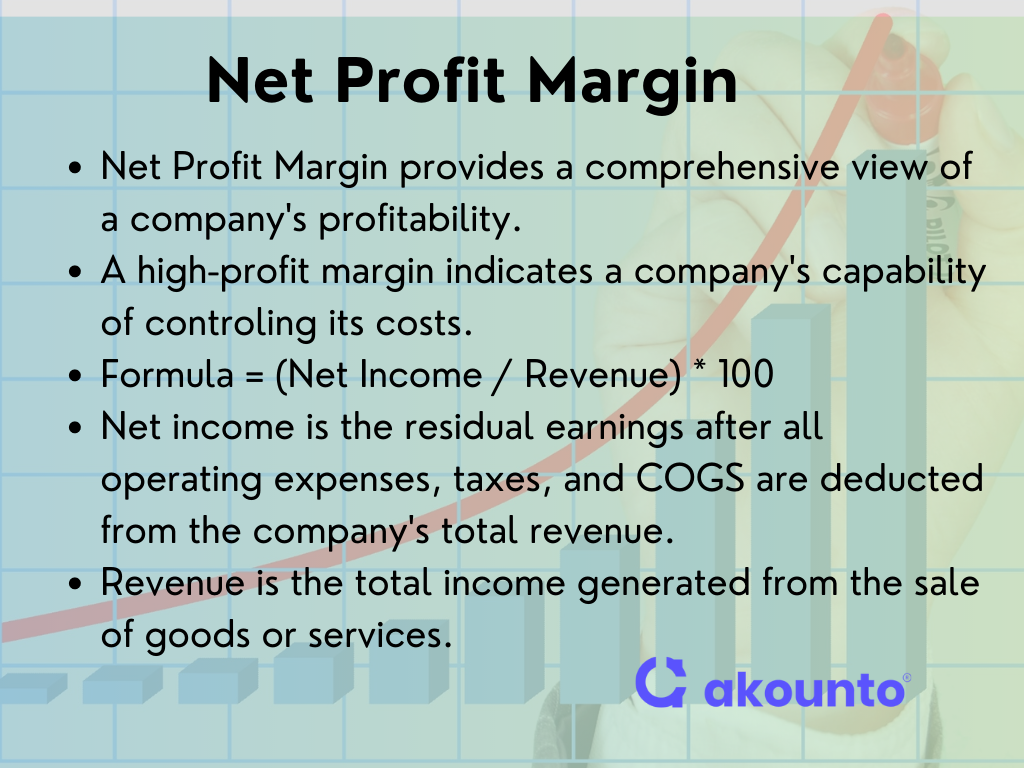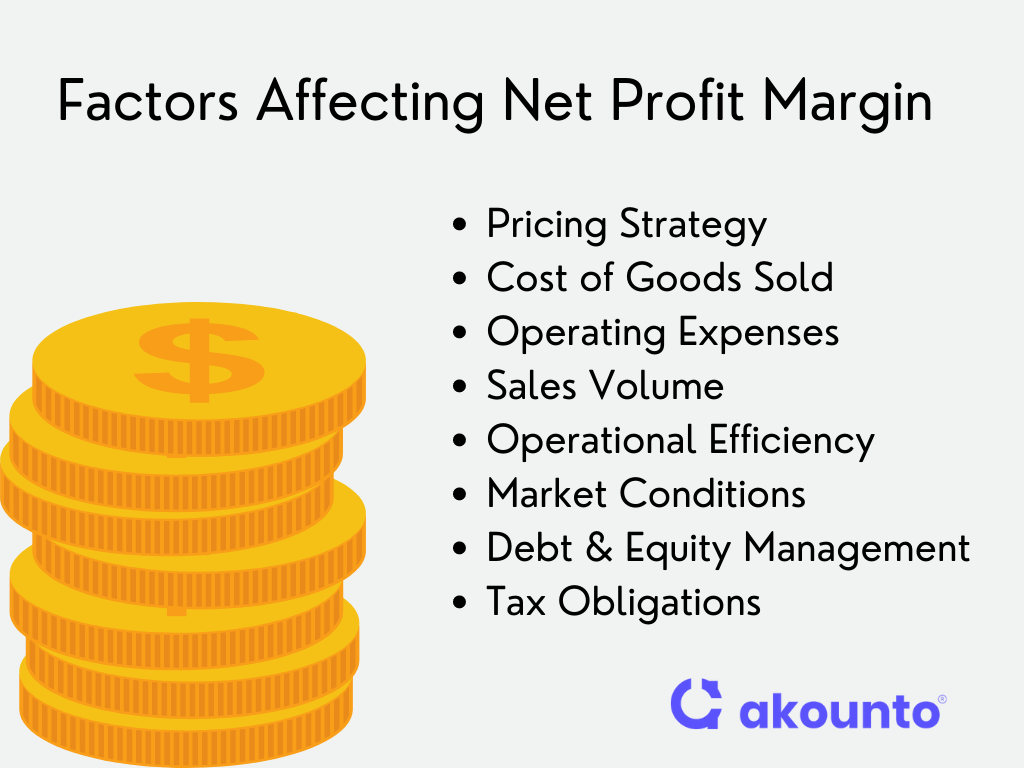Introduction to Net Profit Margin
The net profit margin ratio how’s how much net profit a company makes for every dollar of revenue it generates. It is expressed as a percentage.
What’s covered in the article
The net profit margin measures a company’s financial health and provides a clear picture of a company’s profitability after accounting for all costs and expenses.
The company’s net profit margin is a benchmark for comparing a company’s performance against industry peers and companies within the same industry, offering deep insights into the competitive environment and its position.
The net profit margin shows how effectively a company is managing its costs and utilizing its resources. A higher net profit margin indicates that a company is more efficient at converting revenue into actual profit. While a lower net profit margin could signal potential issues, such as high costs, that could be eating into the profits.
Net profit margins are part of a broader set of financial ratios used by business owners, investors, stakeholders, and analysts to assess a company’s financial performance and stability.
Significance
The net profit margin is calculated from the company’s income statement and serves as a reliable financial metric to gauge the company’s profitability. The net profit margin measures the company’s ability to manage its expenses and generate profit from its revenue.
A high net profit margin is often seen as a positive indicator, suggesting that the company efficiently converts its revenue into profit. It implies that the company has effective cost-control measures and can retain a substantial portion of the revenue as net income leading to increased investor confidence and potential for share price growth.
A low net profit margin indicates high operating costs, pricing strategy issues, or other challenges that reduce the net income the company retains from its revenue. This could be a red flag for investors and may warrant further investigation.
The net profit margin is important as it measures how much revenue is transformed into profit after all expenses are deducted. It clearly shows the company’s financial health and operational efficiency.
Comparing companies’ net profit margins within the same industry can provide valuable insights, identify industry standards, reveal competitive advantages, and highlight areas for improvement.
Net Profit Margin Calculation

The formula for the net profit margin is derived from the company’s income statement.
Net Profit Margin Formula
The net profit margin formula is as follows:
Net Profit Margin = (Net Income / Revenue) * 100
‘Net Income‘ represents a company’s profit after all expenses, taxes, and costs have been deducted from the total revenue.
‘Revenue’ here refers to the total income generated from the sale of goods or services.
The result is then multiplied by 100 to express it as a percentage.
This formula provides the net profit margin, a key profitability ratio showing the percentage of each dollar of revenue a company retains as profit.
Interpretation
- The net profit margin is important as it provides a snapshot of a company’s profitability. It shows how much of the sales revenue is left as net income after all expenses are accounted for.
- A good net profit margin varies by industry, but generally, a higher profit margin indicates a more profitable company with better control over its costs than its competitors.
- The net income in the formula is the residual earnings after all operating expenses, taxes, and cost of goods sold (COGS) are deducted from the company’s total revenue.
- Gross profit, on the other hand, only takes into account the COGS, not the operating expenses or taxes. Therefore, the net profit margin provides a more comprehensive view of profitability.
- A company’s cost structure can significantly influence the margin ratio or net profit margin. Companies with high operating expenses may have lower net profit margins.
- Sales revenue is the total income from the sale of goods or services. A company with high sales revenue may not necessarily have a high net profit margin if its costs are also high.
Examples
Example 1
Company A has a total revenue of $500,000 and a net income of $100,000.
The net profit margin would be calculated as (100,000 / 500,000) * 100 = 20%.
Interpretation:
This means that Company A retains 20 cents of every dollar of revenue as profit. Company A has a healthy net profit margin, indicating efficient cost management and profitability.
Example 2
Company B operates in the manufacturing industry and has total sales revenue of $1,000,000.
The cost of goods sold (including direct costs like raw materials and direct labor) amounts to $400,000. Operating expenses (rent, utilities, salaries, etc.) total $300,000.
The company also has interest expenses of $50,000 due to debt financing and pays income taxes of $100,000.
Calculate net profit margin.
Solution
To calculate the net income, subtract all the expenses from the total sales revenue:
Net Income = $1,000,000 – $400,000 – $300,000 – $50,000 – $100,000 = $150,000.
The net profit margin would be (150,000 / 1,000,000) * 100 = 15%.
Interpretation
In the above net profit margin example, despite high total sales, Company B’s net profit margin is relatively low at 15%, suggesting high operating costs, interest expenses from debt financing, and tax obligations significantly reducing its profitability. Company B may need to explore strategies to reduce costs and improve efficiency to increase its net profit margin.
Example 3
Company C has the following financial information:
Total revenue = $200,000
Cost of goods sold = $50,000
Administrative expenses = $30,000
Overhead costs, including equipment maintenance = $20,000
Interest expenses = $10,000
Cash inflow = $5,000 from non-operating income
Calculate net profit margin.
Solution
To calculate the net income, we subtract all these expenses from the total revenue:
Net Income = $200,000 – $50,000 – $30,000 – $20,000 – $10,000 + $5,000 = $95,000.
The net profit margin calculation: (95,000 / 200,000) * 100 = 47.5%.
Interpretation
Despite having various expenses, including higher interest expenses, Company C has managed to maintain a healthy net profit margin of 47.5%, indicating efficient management of operating margin and effective control over costs, resulting in a strong cash flow.
Factors Affecting Net Profit Margin

- Pricing Strategy: The price at which a company sells its goods or services directly affects its sales revenue and, consequently, its net profit margin. A well-balanced pricing strategy can maximize both sales volume and profit margin.
- Cost of Goods Sold (COGS): This includes all the direct costs of producing a company’s goods or services. A high COGS can lower the net margin.
- Operating Expenses: These are associated with running the business, excluding the cost of producing goods or services. High operating expenses can reduce the net profit margin.
- Sales Volume: The total quantity of goods or services sold can impact the net profit margin. Higher sales volume can lead to a higher net margin if costs are controlled effectively.
- Efficiency: The efficiency of operations, including production, marketing, and management processes, can significantly affect the net margin. More efficient operations can lead to lower costs and higher net profit margins.
- Market Conditions: Competition, demand, and economic conditions can influence the net profit margin. For instance, high demand can lead to increased sales revenue and potentially a higher net margin.
- Financial Management: How a company manages its finances, including debt and equity financing, can impact the net profit margin. High-interest expenses from debt financing can reduce net income and lower the net profit margin.
- Tax Obligations: The amount a company pays in taxes can affect its net income and net profit margin. Higher taxes reduce net income, thus lowering the net profit margin.
Limitations
- The net margin doesn’t consider the impact of leverage or debt, which can significantly affect a company’s profitability.
- It may not provide a comprehensive view of a company’s financial health if non-operating items significantly impact net income.
- It can vary greatly across different industries, making cross-industry comparisons less meaningful.
- It doesn’t account for the size or scale of a company. Larger companies may have lower net profit margins but higher total profits.
- It is a historical measure and may not accurately predict future profitability.
Net Vs. Gross Profit Margin
| Net Profit Margin | Gross Profit Margin | |
| Definition | The net profit margin is a profitability ratio that shows the percentage of each dollar of revenue that a company retains as net income after all expenses are deducted. | The gross profit margin is a profitability ratio that shows the percentage of each dollar of revenue that a company retains as gross profit after the cost of goods sold (COGS) is deducted. |
| Calculation | Net Profit Margin = (Net Income / Revenue) * 100 | Gross Profit Margin = (Gross Profit / Revenue) * 100 |
| What It Measures | The net profit margin measures a company’s overall profitability, taking into account all operating and non-operating expenses. | The gross margin measures a company’s efficiency in producing its goods or services, considering only the cost of production. |
| Income Statement Line Items | The net profit margin calculation uses net income, which is found at the bottom of the income statement after all expenses, taxes, and interest have been deducted from revenue. | The gross margin calculation uses gross profit, which is found on the income statement after subtracting the cost of goods sold from revenue. |
| Significance | The net profit margin provides a comprehensive view of a company’s profitability and financial health. It is a key indicator of how well a company is managing all its costs. | The gross margin provides insight into a company’s operational efficiency. It shows how well a company is managing the costs directly associated with producing its goods or services. |
Conclusion
Net profit margin provides insights into how effectively a company manages its costs and converts revenue into profit. By comparing net profit margins, businesses can benchmark their performance against industry peers and identify areas for improvement.
Learn more with similar knowledgeable articles from Akounto’s blog.











